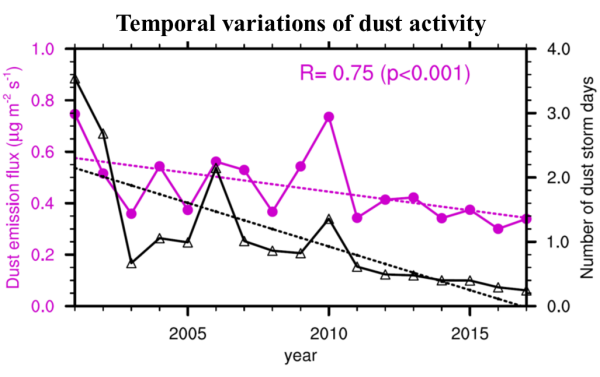Dust storms can be miles long and thousands of feet high. Some call it "disaster" because it has many environmental consequences including severe air pollution, land degradation, and damage to crop and livestock. Not many people are aware that dust entrained into the atmosphere also serves as a major aerosol type, exerting a significant effect on weather and climate system via aerosol-radiation-cloud interactions and delivering nutrients from continents to other continents and oceans. Dust storm is also regarded as an important mechanism for the formation of loess sediments.
"It is important to understand the evolution of dust activity in the past and project its changes in the future." said Dr. WU Chenglai, the corresponding author of a study published in Nature Communication, which investigate the factors driving the recent decline of East Asian dust activity. "In fact, because of its natural origin, dust can serve as a mirror to understand the evolution of Earth System."
In recent decades, East Asian dust activity has decreased greatly. In particular, there is a strong decline of dust activity after a dusty period of 2000-2002. What are the reasons for the recent decline of dust activity in East Asia? How will dust activity change in the future? It is of great concern whether this decreasing trend is going to continue.
"Dust emission depends on various factors including surface winds, soil conditions, vegetation cover, and human disturbances." explained Prof. LIN Zhaohui, also the corresponding author of the study. "The essential part of our study is to use a physically-based dust emission model (DuEM) to reconstruct the dust emission flux from 2001 to 2017. Our results show that the model reproduces well the interannual variations and decreasing trends of dust activity in East Asia during 2001 to 2017."
Then, the research team conduct several sensitive experiments with one individual factor varying during 2001-2017 but other factors fixed to the level of the beginning year (i.e., year 2001). By comparing these experiments, they isolate the impacts of surface wind, soil moisture, and vegetation cover on the temporal variations of dust emission during 2001-2017. "The conclusion is that the weakening of surface wind and the increase of vegetation cover and soil moisture all contributes to such dust emission reduction. The relative contributions of these three factors are 46%, 30%, and 24%, respectively." Explained Wu.
"Overall, changes in meteorological factors are the main drivers for recent decline in dust activity over East Asia." Emphasized Wu. In fact, the weakening of surface wind can be ascribed to the reduced meridional temperature gradients due to the polar amplification of global warming. The weakening can also be partly explained by internal variability in the climate system such as the Pacific Decadal Oscillation (PDO). Increase of vegetation cover is closely related to the increase of CO2 concentrations and temperature as well as ecological restoration in China. Soil wetting may be mainly ascribed to the increase of precipitation in the source regions.
"We have got to take into account the evolution of all these relevant factors for projecting future dust change in this region." suggested Wu.
Figure 1. The temporal variations of observed dust storm days (black curve) and simulated dust emission flux (magenta curve) averaged at the synoptic stations over Eastern Sources (35-49 oN, 94-126.5oE) during 2001–2017. The correlation between two curves is 0.75 (p < 0.001). Also shown are the linear trends (dash lines; p < 0.1).
This study can also provide a reliable clue for future prediction of dust storm activity. The simulated dust emission is available for download at
Science Data Bank repository.
This work was supported by the National Key Research and Development Program of China and the National Natural Science Foundation of China. The numerical experiments were conducted at “Earth System Science Numerical Simulator Facility” (EarthLab) which was supported by the National Key Scientific and Technological Infrastructure project (https://earthlab.iap.ac.cn/en/).
Citations:
Wu, C., Lin, Z., Shao, Y., Liu, X., and Li, Y. Drivers of recent decline in dust activity over East Asia. Nat Commun 13, 7105 (2022). https://doi.org/10.1038/s41467-022-34823-3
Wu, C., Lin, Z. Hourly dust emission flux over East Asia during 2001 to 2017[DS/OL]. Science Data Bank, 2022[2022-11-19]. https://doi.org/10.57760/sciencedb.03301

